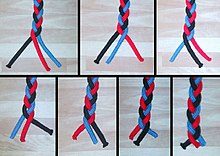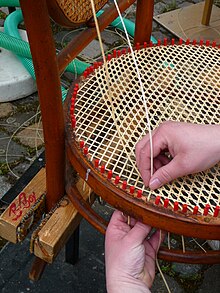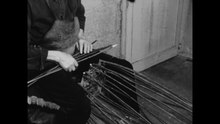Braiding (technique)
The activity "braiding" is the regular interweaving of several strands of flexible material. The difference to weaving is that during braiding the threads are not fed at right angles to the main product direction.
The weaving trade has been recognized as an intangible cultural heritage in Germany. In December 2016, the German Commission for UNESCO included wickerwork in the nationwide register of intangible cultural heritage .
Areas of application
Many materials are suitable for braiding, so this method is used in very different areas. Braiding can be done both by hand and by machine. Some examples are given here for explanation:
- the braiding of three strands or strands of hair into a pigtail
- the braiding of leather strips or cords into straps for belts, for example
- the basket weaving and braiding of mats, so the production of wattle by interlocking loops of flexible material, especially from Bast , pasture , brushwood , rattan , rush . This sub-meaning also includes rectangular interweaving, for example when rush mats or willow fences are made.
- in blacksmithing, the interweaving of the same or differently identical steel strands in the glowing state
- the intertwining of strands of dough, for example with yeast plaits or pretzels
- machine braiding of several threads to cords or braids , whereby one usually
- with an even number of threads from a round braid or a cord
- in the case of odd numbers speaks of a flat braid or a stranded wire. ( see braiding machine ) Four- and multi-pole cables are made from insulated copper strands, particularly flexible stranded cables from non-insulated, flat desoldering strands and pulling grips are made from steel wire.
- technically demanding products such as B. ropes . A field of application of wire ropes are suspension bridges or rope bridges as a well-known example . Meanwhile, the first suspension bridges in China or South America for more than 1000 years were made of leather or plant fibers - like the last remaining suspension bridge of the Incas made of grass (Ichu grass) , the Q'iswachaka .
- Manufacture of so-called 3D braids with variable cross-sectional contours as in Plattings and Scoubidous , etc. a. for fiber composite components or medical applications such as stents .
A typical feature of Thonet's bentwood chairs is the woven seat made of Viennese weave, also known as an octagonal or honeycomb weave. Thin rattan strips about 2.5 mm wide run taut in four directions (every 45 °) and are knotted in the vertical holes in the frame.
The history of carpet production knows the knotted carpet .
As a folk dance, there is the so-called band dance , where the dancers each hold a band and dance in opposite directions around a tree or a pole, thus braiding the bands attached above around this tree.
history
The history of braiding goes back to the prehistoric times of mankind. Believing it to be one of the oldest crafts is based on the fact that it uses almost no tools apart from the hands.
In addition, there was already a need in the time of hunters and gatherers , e.g. B. to transport and store collected fruits, nuts etc. In addition to fur bags or hollowed-out plants such as pumpkins , baskets and carrier bags woven from rushes , raffia and similar materials were suitable for this.
Bast remnants from linden and oak represent the most common finds of Neolithic fiber remains. The long fibers of these tree species were used as a material for making baskets , mats and cords . The currently best-known examples are probably the cape and shoes of the man from Tisenjoch, commonly known as " Ötzi ".
literature
- Bruce W. Miller, Jim Widess: The Book of Woven Chair: Restoring Coverings. Cane, cane, wood chip, rawhide, paper cord and wicker furniture. Vincentz Network GmbH & Co KG, 2005, ISBN 3-87870-572-7 .
- Kulturverein Dorfleben: Braiding in the Styrian volcanic region. Stainz bei Straden 2012 ( online ).
- Susie Vaughan: Simply basket weaving. Verlag Ökobuch, 2005, ISBN 3-936896-14-3 .
- Hilary Burns: Willows, rushes, rattan: weaving with natural materials. Haupt Verlag AG, 2000, ISBN 3-258-06045-2 .
Web links
Individual evidence
- ↑ Yordan Kyosev: Braiding technology for textiles . Ed .: Woodhead Publishing. Woodhead Publishing, 2014, ISBN 978-0-85709-135-2 , pp. 416 .
- ↑ http://www.unesco.de/kultur/immaterielles-kulturerbe/bundesweites-verzeichnis/eintrag/flechthandwerk.html






